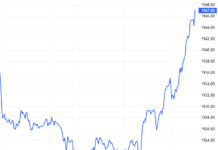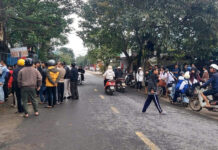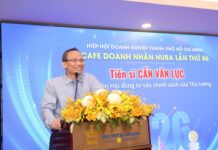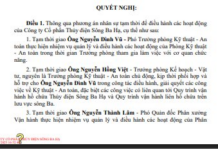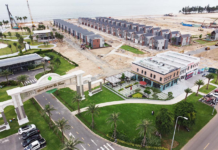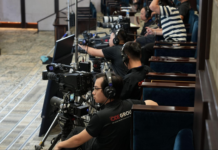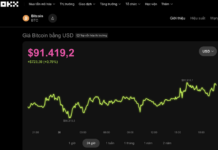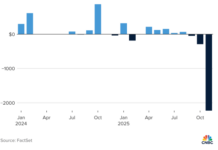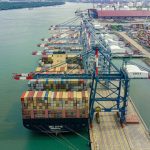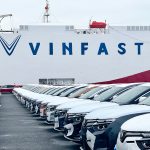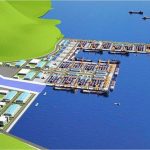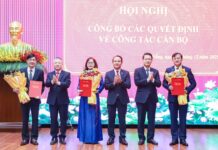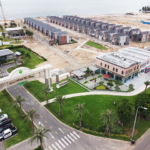
Deputy Prime Minister Tran Hong Ha speaks at a meeting with several ministries, sectors, and localities on the draft Detailed Planning for a group of seaports, wharves, piers, moorings, and water areas for the period 2021-2030, with a vision towards 2050 – Photo: VGP/Nguyen Hoang
Do not hinder creativity and effectiveness
Deputy Minister of Transport Nguyen Xuan Sang stated that the Detailed Planning for the group of seaports aims to concretize the Master Plan for the system of seaports, serving as a basis for policy formulation and solutions to develop seaports that meet the socio-economic development needs and ensure national defense and security for localities, regions, and the whole country.
The planning is detailed up to individual seaports and wharf areas, determining the number of wharves and piers, and the type of ports by 2030: a number of large-scale wharf and port areas are expected between 2030 and 2050 to facilitate investment promotion (Nam Do Son, Con Ong-Hon Net, Lien Chieu, Can Gio, Cai Mep Ha, Cai Mep Ha downstream, Tran De).
In addition, the planning also proposes content related to the development of public maritime infrastructure; orientation for connecting transport infrastructure; and orientation for the development of other piers and wharves to serve as a basis for implementation in subsequent plannings or as a basis for reporting to competent authorities for consideration and approval during the approval stage of the investment policy and preparation.
At the same time, it identifies land and water area requirements; investment capital needs; a list of priority tasks for investment by 2030; and implementation solutions…
The planning sets out targets for cargo and passenger volumes and infrastructure development for each group of seaports and ports, and wharf areas (determining the number of wharves and piers) based on forecasts. Specifically, by 2030, the total cargo and passenger volume handled by the seaport system is expected to be between 1,249 and 1,493 million tons (including containers from 46.3 to 54.3 million Teu); and passengers from 17,382 to 18,845 million turns…

Leaders of ministries and sectors reporting at the meeting – Photo: VGP/Nguyen Hoang
Concluding on this content, Deputy Prime Minister Tran Hong Ha emphasized that the planning must be synchronous and unified, based on scientific criteria, “dynamic and open” to allow for timely adjustments and updates regarding technology, management methods, and changes in the region and internationally…
At the same time, propose a number of mechanisms and policies to develop safe and convenient port infrastructure, and efficient investment for the world’s leading shipping lines, with the overall management and administration of the State, promoting the capacity and creativity of investors.
The Ministry of Transport, planning consultants, and relevant agencies shall ensure the completeness of dossiers and compliance with legal procedures regarding planning, maritime, and transport matters; the accuracy and scientific basis of data used for evaluation and forecasting; and the consistency and synchronization with sectoral plannings, regional plannings, and local plannings.
The Deputy Prime Minister also requested the Ministry of Transport to regularly monitor and report on any unexpected changes beyond the forecasts so that the “planning does not hinder creativity and effectiveness”. Any new content added to the planning should be evaluated for its objectives and overall effectiveness, especially its relationship and impact on large and strategic projects.

Deputy Prime Minister Tran Hong Ha: The design of the Saigon International Transit Port must be synchronous, holistic, and detailed for the 7 investment phases – Photo: VGP/Nguyen Hoang
Careful study and comprehensive evaluation of the Saigon International Transit Port Project
Also at the meeting, the Ministry of Planning and Investment reported on the Saigon International Transit Port Project in Can Gio District, Ho Chi Minh City, which will provide services related to the operation of a seaport container terminal; with an expected scale of 571 ha and a total investment capital of about VND 113,500 billion. The project is expected to be implemented in 7 phases over 22 years.
At the meeting, the leaders of the ministries, sectors, and Ho Chi Minh City discussed and analyzed the progress, total investment capital, technical infrastructure, and traffic connectivity of the project.
According to Mr. Nguyen Canh Tinh, the project is assessed to be highly feasible because the cargo volume has been determined. He requested Ho Chi Minh City to direct solutions to ensure land allocation for the project in a timely manner at each stage; and to develop and publicly announce clear criteria and conditions for attracting investment, as well as the issues that investors need to commit to.
Deputy Minister of Natural Resources and Environment Le Cong Thanh and the representative of the Ministry of Foreign Affairs expressed their opinions, stating that the project is located in the buffer zone of the Can Gio Mangrove Biosphere Reserve, a regenerated mangrove forest recognized by UNESCO. Therefore, the implementation of the project needs to carefully evaluate its impacts on the environment, nature conservation, and marine resources… At the same time, provide more specific evaluations on the planning and land use in the area surrounding the project; and the compatibility of the project’s planning with the overall planning…
The People’s Committee of Ho Chi Minh City affirmed and committed that the detailed assessment of the project’s environmental impacts would be carefully studied and evaluated during the preparation of the project’s feasibility study report in accordance with the law on environmental protection, ensuring no negative impact on the Can Gio Mangrove Biosphere Reserve.
The requirements for investors regarding modern and environmentally friendly exploitation technology, ensuring that the investment, construction, and operation of the port do not affect the ecological environment, especially the Can Gio Mangrove Biosphere Reserve, will be studied and built into the criteria for selecting the investor for the construction of the port.
Vice Chairman of the Ho Chi Minh City People’s Committee Bui Xuan Cuong reported and exchanged views on specific issues related to planning, changes in forests during project implementation, and traffic connectivity of the project; as well as the mobilization and arrangement of capital for the implementation of the project’s components…
Emphasizing that the project implementation period is quite long, Deputy Minister of Science and Technology Hoang Minh requested that the project report should clarify the trends in technology development and the issues of technology transfer for the project’s components. He added that a long implementation period without proper forecasting of technology trends may result in outdated technology choices.
Concluding the meeting, the Deputy Prime Minister assigned the Ministry of Planning and Investment to coordinate with the Ministries of Agriculture and Rural Development, Natural Resources and Environment, Transport, the People’s Committee of Ho Chi Minh City, and relevant ministries and sectors to review the synchronization and unity of the project with related plannings, and urgently complete the necessary dossiers for appraisal and approval of the investment proposal.
Continue to clarify the specific objectives in each phase and the “project life cycle” in accordance with the law; and supplement requirements and orientations for the transfer of modern technology…
“The design of the Saigon International Transit Port must be synchronous, holistic, and detailed for the 7 investment phases, clearly defining the location of functional areas, addressing the relationship with other port clusters, shared infrastructure, connectivity, human resource training,…”, the Deputy Prime Minister noted, emphasizing, “Do not neglect or sacrifice the environment”, ensuring overall benefits, harmony, and avoiding conflicts with other projects.
The project must contribute to the goal of developing a number of seaports capable of competing internationally and regionally; finding investors with technological capacity, human resources, and management skills…; attracting major shipping lines in the world; and having a roadmap for transformation into an eco-friendly port with accompanying infrastructure…
VinFast’s Factories in Hai Phong, US, India, and Indonesia Share a Crucial Feature That Makes Their Cars Tens of Thousands of Dollars Cheaper
Vinfast, the Vietnamese automaker led by Pham Nhat Vuong, has strategically established factories in key markets, positioning itself as a significant player in the global electric vehicle industry.
“Expedite Lien Chieu Port Construction: Ministry of Transport Urges Da Nang to Hasten Collaboration”
The Lien Chieu Port construction project is slated for completion by November 2025. The Prime Minister has tasked the Danang People’s Committee with expediting procedures to select a capable investor for the development and operation of the port. Despite these efforts, the project is yet to secure an investor.

